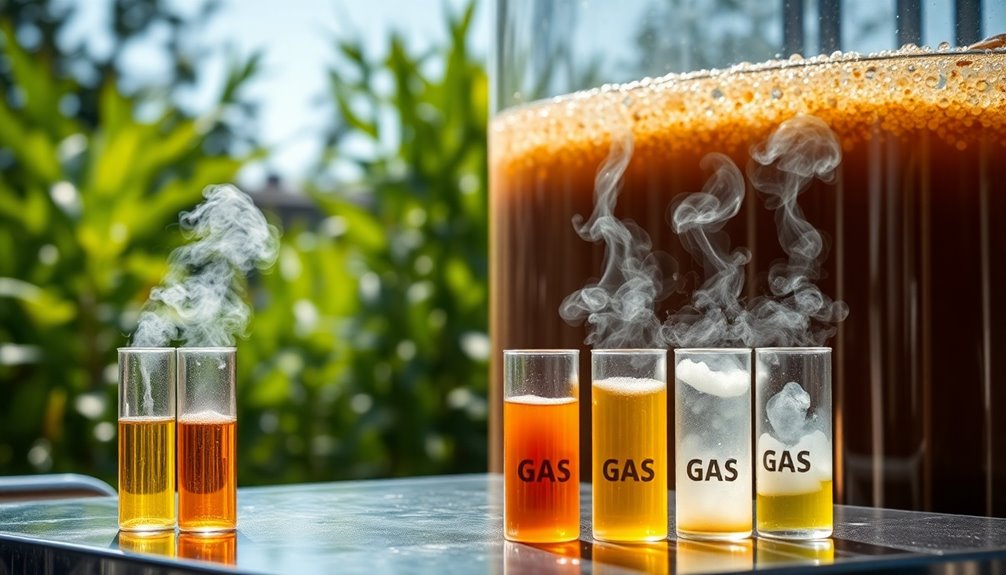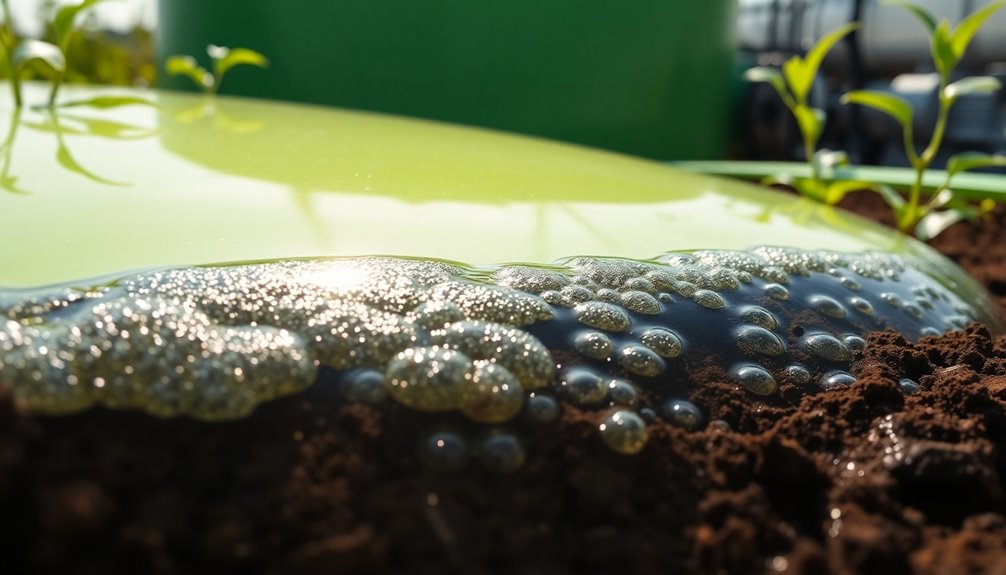Semi-thermophilic anaerobic digestion operates best between 40°C and 50°C, with optimal results at around 45°C. It offers greater methane yields than mesophilic conditions while managing organic waste effectively. This method promotes a diverse microbial community, enhancing digestion efficiency and stability. Although challenges like energy demands and pathogen inactivation exist, the process has significant potential for energy recovery. Stick around to discover more about its benefits and implementation strategies.
Key Takeaways
- Semi-thermophilic anaerobic digestion operates optimally at 45°C, balancing microbial activity and stability for enhanced methane production.
- The process can achieve methane yields of 250-300 mL/g VS, surpassing mesophilic digestion efficiency.
- A diverse microbial community fosters synergistic interactions, improving digestion efficiency and resilience against operational challenges.
- Maintaining pH levels between 6.8 and 7.4 is crucial for maximizing microbial activity and ensuring stable digestion conditions.
- Effective management of organic loading rates and retention times enhances biogas quality while supporting pathogen inactivation.

As you explore the potential of semi-thermophilic anaerobic digestion for methane production, you'll find it operates within a temperature range of 40°C to 50°C, striking a balance between stability and high biogas yields. This unique temperature range supports a diverse microbial community, which includes both mesophilic and thermophilic microorganisms.
By harnessing the strengths of both kinds, semi-thermophilic digestion offers more operational stability than thermophilic digestion while potentially yielding greater amounts of biogas compared to mesophilic digestion.
To achieve optimal results, you should aim for a temperature around 45°C. It's also essential to monitor organic loading rates (OLRs), which should fall between 2 to 10 g VS/L·day, depending on your substrate and reactor design. Retention times typically range from 10 to 30 days, while maintaining pH levels between 6.8 and 7.4 is crucial for active microbial activity.
Aim for a temperature of 45°C, monitor OLRs of 2-10 g VS/L·day, and maintain pH levels between 6.8 and 7.4 for optimal anaerobic digestion.
A diverse microbial community bolsters digestion efficiency and resilience, making your process more effective. The biochemical processes involved in semi-thermophilic digestion include hydrolysis, acidogenesis, acetogenesis, and methanogenesis. Additionally, thermophilic microorganisms are explored for their potential to enhance biogas yield, contributing to the overall efficiency of the digestion process.
These stages break down complex organic materials into simpler compounds, ultimately converting them into methane and carbon dioxide. Syntrophic interactions among microorganisms enhance this efficiency, allowing you to maximize methane production.
Research indicates that semi-thermophilic conditions can achieve methane yields of up to 250-300 mL/g VS, outperforming mesophilic conditions. Additionally, this process can remove up to 60% of volatile solids, improving biogas quality.
Not only does this method effectively manage organic waste, but it also recovers energy for electricity generation or heating, making it a valuable resource.
While semi-thermophilic anaerobic digestion isn't without its challenges—such as requiring careful management of stability, energy demands, and pathogen inactivation—it remains a promising option for enhancing methane production and ensuring effective waste management.
Frequently Asked Questions
What Are the Economic Benefits of Semi-Thermophilic Anaerobic Digestion?
Semi-thermophilic anaerobic digestion offers you several economic benefits.
You can save on energy costs by utilizing biogas for on-site power generation. This process reduces your need for synthetic fertilizers, thanks to nutrient-rich digestate.
You might also create local jobs during construction and operation. Additionally, selling excess biogas and carbon credits can generate revenue, while optimized methane production enhances your returns, making it a cost-effective solution for waste management and energy needs.
How Does Semi-Thermophilic Digestion Compare to Mesophilic Processes?
Semi-thermophilic systems shine when you compare them to mesophilic processes. They strike a sweet balance between speed and stability, offering higher methane yields without the chaos of full thermophilic conditions.
You'll find that semi-thermophilic digestion produces better biogas composition, while maintaining microbial diversity. Plus, it addresses some stability issues, making it a smart choice for efficient energy production.
If you're looking for a middle ground, this approach could be ideal for you!
What Feedstocks Are Best Suited for Semi-Thermophilic Anaerobic Digestion?
When considering feedstocks for semi-thermophilic anaerobic digestion, you'll want to prioritize those with high organic content, like food waste and agricultural residues.
Aim for a balanced carbon-to-nitrogen ratio between 20 and 30 to optimize digestion.
Additionally, using pretreatment methods can enhance the digestibility of complex materials.
Moisture levels matter too, as they can affect stability, so keep those in check for the best results in methane production.
What Are the Potential Environmental Impacts of This Digestion Process?
Think of anaerobic digestion as a green guardian, protecting our planet while turning waste into energy.
This process offers numerous environmental benefits, such as reducing methane emissions and improving water quality by treating organic waste.
It also enhances soil fertility through nutrient recovery and minimizes the use of chemical fertilizers.
You'll find that it effectively controls odors and pathogens, contributing to a healthier ecosystem and fostering a sustainable future for everyone.
How Can Operational Parameters Be Optimized for Better Methane Yields?
To optimize operational parameters for better methane yields, you should maintain the temperature between 37°C and 45°C, ensuring stability for microorganisms.
Carefully manage the organic loading rate to prevent acidification, and gradually increase it in stages to support microbial resilience.
Monitor pH closely, keeping it between 6.8 and 7.8, while controlling oxidation-reduction potential to promote efficient methanogenesis.
These measures will enhance your methane production significantly.
Conclusion
In conclusion, semi-thermophilic anaerobic digestion proves to be a promising approach for enhancing methane production and stability. By operating at moderate temperatures, this method optimizes microbial activity while minimizing energy costs. Visualizing the process shows a clear relationship between temperature, microbial efficiency, and methane yield. Adopting this technology could lead to more sustainable waste management practices, making it a valuable solution for energy recovery. Embracing these advancements can significantly impact the future of renewable energy.









